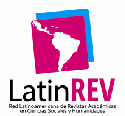Tuits saludables: El uso e importancia de Twitter para la prevención en salud
DOI:
https://doi.org/10.26439/contratexto2017.n028.1554Resumen
Las redes sociales han cambiado la manera como las personas se informan, comunican y comparten ideas. Estas plataformas sociales se usan para muchos fines, desde estar en contacto con familiares y amigos hasta promocionar productos. Sin embargo, muy poco se conoce sobre su utilidad para la comunicación y prevención en salud, principalmente en comunidades de habla hispana. En ese sentido, esta investigación analiza el empleo e importancia de las redes sociales como herramienta para la prevención de problemas relacionados con la salud en comunidades hispanas. Para ello, desarrolla una metodología cuantitativa y realiza un análisis de contenido de 3000 mensajes en Twitter con el hashtag #prevención. Los resultados indicaron que la mayoría de los mensajes de prevención fueron unidireccionales y muy pocos usuarios promovieron la comunicación y la movilización. Los medios de comunicación y las agencias gubernamentales fueron los usuarios que más enviaron mensajes, principalmente, sobre temas relacionados con la salud pública y vial. Este estudio resalta las diversas potencialidades y funcionalidades de las redes sociales, específicamente Twitter, para contribuir a la prevención y comunicación en salud. Sus hallazgos son útiles al momento de llevar a cabo campañas o contenido de prevención a través de estas plataformas.
Descargas
Referencias
Anand, S., Gupta, M., y Kwatra, S. (2013). Social media and effective health communication. International Journal of Social Science & Interdisciplinary Research, 2(8), 39-46.
Antheunis, M.L., Kiek, T., y Nieboerb, T.E. (2013). Patients’ and health professionals’ use of social media in health care: Motives, barriers and expectations. Patient Education and Counseling, 92 (3), 426–431. DOI= http://dx.doi.org/10.1016/j.pec.2013.06.020F.
Bruns, A. y Burgess, J. (2014). Crisis communication in natural disasters: The Queensland Floods and Christchurch Earthquakes. En Weller, K., Bruns, A., Burgess, J., Mahrt, M., y Puschmann, C. (eds.). Twitter and Society, Peter Lang, New York, 373-384.
Burkhardt, P. (2009). Social Software Trends in Business: Introduction. En Tiako, P. (ed.). Software Applications: Concepts, Methodologies, Tools, and Applications. Hershey: Information Science Reference, pp. 3180-3195. doi:10.4018/978-1-60566-060-8.ch184.
Cha, M., Haddadi, H., Benevenuto, F., y Gummadi, P. K. (2010). Measuring user influence in Twitter: The million follower fallacy. Proceedings ICWSM, 10, 30.
Cheon, F. y Cheong, C. (2011). Social media data mining: A social network analysis of tweets during the 2010-2011 Australian floods. PACIS 2011 Proceedings. Recuperado de http://aisel.aisnet.org/pacis2011/46/
Chew C. y Eysenbach G. (2010). Pandemics in the age of Twitter: content analysis of Tweets during the 2009 H1N1 outbreak. PLoS One, 5(11). DOI= 10.1371/journal.pone.0014118.
Curioso, W.; Alvarado Vásquez, E. y Calderón Anyosa, R. (2011). Usando Twitter para promover la educación continua y la investigación en salud en el Perú. Revista Peruana de Medicina Experimental y Salud Pública, 28(1), 163-164.
De Choudhury, M., Ringel Morrys, M., & White, R. (2014). Seeking and Sharing Health Information Online: Comparing Search Engines and Social Media. In CHI '14 Proceedings of the SIGCHI Conference on Human Factors in Computing Systems.
Dynes, R.R. y Quarantelli, E.L. (1968). Group behavior under stress: A required convergence of organizational and collective behavior perspectives. Sociology and Social Research, 52, 416-428.
Donelle, L. y Booth, R.G. (2012). Health Tweets: An Exploration of Health Promotion on Twitter. The Online Journal of Issues in Nursing, 17 (3), Manuscript 4 DOI= 10.3912/OJIN.Vol17No03Man04.
Eberle, D., Berens, G. y Li, T. (2013). The impact of interactive Corporate Social Responsibility Communication on Corporate Reputation. Journal of Business Ethics, 118, 731-746. DOI = 10.1007/s10551-013-1957-y.
Fox, S. (2010). Mobile health 2010. Pew Research Center Internet & Technology. Recuperado de http://www.pewinternet.org/2010/10/19/mobile-health-2010/
Fox, S. y Jones, S. (2009). The Social Life of Health Information. Pew Research Center Internet & Technology. Recuperado de http://www.pewinternet.org/2009/06/11/the-social-life-of-health-information/
Grajales III, F., Sheps, S., Ho, K., Novak-Lauscher, H., y Eysenbach, G. (2014). Social Media: A Review and Tutorial of Applications in Medicine and Health care. Journal of Medical Internet Research, 16(2). DOI= 10.2196/jmir.2912.
Gold, J., Pedrana, A.E., Sacks-Davis, R., Hellard, M.E., Chang, S., Howard, S., Keogh, L., Hocking, J.S., y Stoove, M.A. (2011). A systematic examination of the use of online social networking sites for sexual health promotion. BMC Public Health, 11(583). DOI= 10.1186/1471-2458-11-583.
Jones, B., Temperley, J., y Anderson, L. (2009). Corporate reputation in the era of Web 2.0. The case of Primark. Journal of Marketing Management, 25(9-10), 927-939. doi:10.1362/026725709X479309.
Karr, D. (2014). 2014 Statistics and Trends for Businesses on Social Media. Marketing Tech Blog. Recuperado de https://www.marketingtechblog.com/2014-statistics-trends-businesses-social-media/
Kaplan, A.M. y Haenlein, M. (2010). Users of the world, unite! The challenges and opportunities of social media, Business Horizons, 53, 59-68. DOI= DOI: 10.1016/j.bushor.2009.09.003.
Kemp, S. (2015). Digital, Social & Mobile Worldwide in 2015. We Are Social. Recuperado de https://edubirdie.com/blog/digital-global-overview
Laranjo, L., Arguel, A., Neves, A.L., Kaplan, R., Mortimer, N., Mendes, G.A., y Lau, A.Y. (2014). The influence of social networking sites on health behavior change: a systematic review and meta-analysis. Journal of American Medical Informatics Association, 22(1), 243-256. DOI: http://dx.doi.org/10.1136/amiajnl-2014-002841.
Lovejoy, K. y Saxton, G. (2012). Information, Community, and Action: How Nonprofit Organizations Use Social Media. Journal of Computer-Mediated Communication, 17(3), 337–353. DOI: 10.1111/j.1083-6101.2012.01576.x.
Mangold, G. y Faulds, D. (2009). Social media: the new hybrid element of the promotion mix. Business Horizons, 52, 357-365. doi:10.1016/j.bushor.2009.03.00.
Moorhead, S.A., Hazlett, D.E., Harrison, L., Carroll, J.K., Irwin, A., y Hoving, C. (2013). A new dimension of Health Care: Systematic Reviews of the Uses, Benefits, and Limitation of Social Media for Health Communication. Journal of Medical Internet Research, 15(4). DOI= 10.2196/jmir.1933.
Orygen Youth Health Research Centre y Young and Well Cooperative Research Centre. (2014). Social media benefits outweigh risks in suicide prevention: new research. Recuperado de http://www.youngandwellcrc.org.au/wp-content/uploads/2014/07/Social-media-benefits-outweigh-risks-in-suicide-prevention_230714.pdf
Paul, M. I. y Dredze, M. (2011). You are what you tweet: Analyzing Twitter for Public Health. Proceedings of the Fifth International AAAI Conference on Weblogs and Social Media. Recuperado de https://www.cs.jhu.edu/~mdredze/publications/twitter_health_icwsm_11.pdf
Shan, L.C., Panagiotopoulos P., Regan Á., De Brún A., Barnett J., Wall P., y McConnon Á. (2015). Interactive communication with the public: qualitative exploration of the use of social media by food and health organizations. Journal of Nutrition Education and Behavior, 47(1), 104-108. DOI= 10.1016/j.jneb.2014.09.00.
Sing, K. y Ajita, J. (2015). A study of tweet chats for breast cancer patients. In Proceedings of the 2015 International Conference on Social Media & Society, Toronto, July 27-29, 2015.
Thackeray, R., Neiger, B.L., Hanson, C.L., y McKenzie, J.F. (2008). Enhancing promotional strategies within social marketing programs: use of Web 2.0 social media. Health Promotion Practice, 9(4), 338-343. doi: 10.1177/1524839908325335.
Thackeray, R., Neiger, B.L., Smith, A.K., y Van Wagenen, S.B. (2012). Adoptions and use of social media among public health departments. BMC Public Health, 12 (242). DOI: 10.1186/1471-2458-12-242.
Thackeray, R., Neiger B.L., Burton S.H., y Thackeray C.R. (2013). Analysis of the Purpose of State Health Department’s Tweets: Information Sharing, Engagement, and Action. Journal of Medical Internet Research, 15(11). DOI= 10.2196/jmir.3002.
Xu, W., Chiu, I.H, Chen, Y., y Mukherjee, T. (2015). Twitter hashtags for health: applying network and content analyses to understand the health knowledge sharing in a Twitter-based community of practice. Quality & Quantity, 49 (4), 1361-1380. DOI=10.1007/s11135-014-0051.
Archivos adicionales
Publicado
Número
Sección
Licencia
Todos los trabajos publicados están sujetos a una licencia CC BY 4.0 Creative Commons (actualizado el 1 de marzo de 2021).
El contenido de la revista se puede compartir en cualquier material o formato. Asimismo, se puede adaptar, contribuir y transformar. Ambas posibilidades sólo están permitidas en la medida en que cumplan las siguientes condiciones:
- Atribución: Se debe otorgar crédito donde sea debido, proporcionar un enlace a la licencia e indicar los cambios en caso se realice alguno. Esto debe hacerse de la manera que se considere apropiada, sin sugerir que el licenciante lo promueva a usted o su uso del material.
Derechos de propiedad
Los derechos patrimoniales de Contratexto se publican bajo una licencia Creative Commons BY 4.0, lo que permite a los autores mantener los derechos patrimoniales de su obra sin restricciones.
Si un trabajo publicado en Contratexto fuera copiado, distribuido, difundido o cualquier otra actividad contemplada en la licencia antes mencionada, se deberá mencionar de manera visible y expresa al autor o autores y a la revista.
Auto-archivo
Esta revista permite y anima a los autores/as a publicar artículos enviados a la revista en sus sitios web personales o en depósitos institucionales, tanto antes como después de su publicación en esta revista, siempre y cuando proporcionen información bibliográfica que acredite, si procede, su publicación en ella.


















